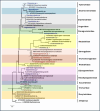One Health implications and first evidence of environmental contamination of helminths in soil from goat farms in Ratchaburi, Thailand
- PMID: 40772988
- PMCID: PMC12331789
- DOI: 10.1007/s00436-025-08541-w
One Health implications and first evidence of environmental contamination of helminths in soil from goat farms in Ratchaburi, Thailand
Abstract
Zoonotic helminths are responsible for the majority of helminthic infections occurring in humans globally. Environmental systems serve as a reservoir for zoonotic helminths, facilitating their transmission to humans and animals. Livestock farms may serve as hotspots for zoonotic transmission, increasing infection risk. Focusing on goat farms in Ratchaburi Province, Thailand, we aim to detect and identify zoonotic helminths present in the soil environment through morphological and molecular techniques. Soil samples (n = 270) were collected from 30 goat farms in Ratchaburi Province, and helminths were morphologically identified using a modified sedimentation and flotation method. Helminths were then molecularly identified using the nuclear 18S rRNA gene and the internal transcribed spacer 2 region. The helminths identified include human, livestock-parasitic nematodes, trematodes, cestodes, plant-parasitic nematodes, insect-parasitic nematodes, and free-living nematodes. Morphological and molecular detection show that 80% and 86% of the farms were positive for helminths, respectively. From 30 farms, 60% were positive for livestock- or human-parasitic helminths, with eight species detected. Moreover, 50% of farms were positive for either Haemonchus contortus or Trichostrongylus colubriformis. Utilizing soil as a non-invasive method for the detection and identification of helminths contaminated in the soil, this study demonstrated the presence of human- and animal-parasitic helminths with the soil matrix serving as a shared environment and reservoir for zoonotic transmission of helminthic infection, further emphasizing the importance of the One Health approach towards mitigating parasitic disease transmission. The findings showed significant implications for the incorporation of soil-based methods into sustainable helminth infection control programs.
Keywords: Goat; One Health; Soil; Thailand; Zoonotic helminths.
© 2025. The Author(s).
Conflict of interest statement
Declarations. Ethics approval and consent to participate: Ethical clearance was provided by the Animal Care and Use Committee, Faculty of Tropical Medicine, Mahidol University, Bangkok (No. FTM-ACUC 004/2024E). Consent to participate in the collection of soil samples was obtained from all goat farm owners and the Ratchaburi Provincial Livestock Office. Consent for publication: Not applicable. Competing interests: The authors declare no competing interests.
Figures






Similar articles
-
Prevalence and risk factors of soil-transmitted helminths in humans and domestic animals in southern Côte d'Ivoire.BMC Infect Dis. 2025 Aug 5;25(1):983. doi: 10.1186/s12879-025-11099-8. BMC Infect Dis. 2025. PMID: 40764530 Free PMC article.
-
Community views on mass drug administration for soil-transmitted helminths: a qualitative evidence synthesis.Cochrane Database Syst Rev. 2025 Jun 20;6(6):CD015794. doi: 10.1002/14651858.CD015794.pub2. Cochrane Database Syst Rev. 2025. PMID: 40539472 Review.
-
Deworming drugs for soil-transmitted intestinal worms in children: effects on nutritional indicators, haemoglobin and school performance.Cochrane Database Syst Rev. 2012 Nov 14;11:CD000371. doi: 10.1002/14651858.CD000371.pub5. Cochrane Database Syst Rev. 2012. Update in: Cochrane Database Syst Rev. 2015 Jul 23;(7):CD000371. doi: 10.1002/14651858.CD000371.pub6. PMID: 23152203 Updated.
-
Refugia or reservoir? Feral goats and their role in the maintenance and circulation of benzimidazole-resistant gastrointestinal nematodes on shared pastures.Parasitology. 2023 Jul;150(8):672-682. doi: 10.1017/S0031182023000380. Epub 2023 May 11. Parasitology. 2023. PMID: 37165895 Free PMC article.
-
Deworming drugs for soil-transmitted intestinal worms in children: effects on nutritional indicators, haemoglobin and school performance.Cochrane Database Syst Rev. 2012 Jul 11;(7):CD000371. doi: 10.1002/14651858.CD000371.pub4. Cochrane Database Syst Rev. 2012. Update in: Cochrane Database Syst Rev. 2012 Nov 14;11:CD000371. doi: 10.1002/14651858.CD000371.pub5. PMID: 22786473 Updated.
References
-
- Amoah ID, Singh G, Stenström TA, Reddy P (2017) Detection and quantification of soil-transmitted helminths in environmental samples: a review of current state-of-the-art and future perspectives. Acta Trop 169:187–201. 10.1016/j.actatropica.2017.02.014 - PubMed
-
- Azian MYN, Sakhone L, Hakim SL, Yusri MY, Nurulsayamzawaty Y, Zuhaizam AH, Rodi I, Maslawaty MN (2008) Detection of helminth infections in dogs and soil contamination in rural and urban areas. Southeast Asian J Trop Med Public Health 39:205–212 - PubMed
-
- Back MA, Haydock P, Jenkinson P (2002) Disease complexes involving plant parasitic nematodes and soilborne pathogens. Plant Pathol 51:683–697
-
- Boreham RE, McCowan M, Ryan AE, Allworth A, Robson J (1995) Human trichostrongyliasis in Queensland. Pathology 27:182–185. 10.1080/00313029500169842 - PubMed
MeSH terms
Substances
Grants and funding
LinkOut - more resources
Full Text Sources

